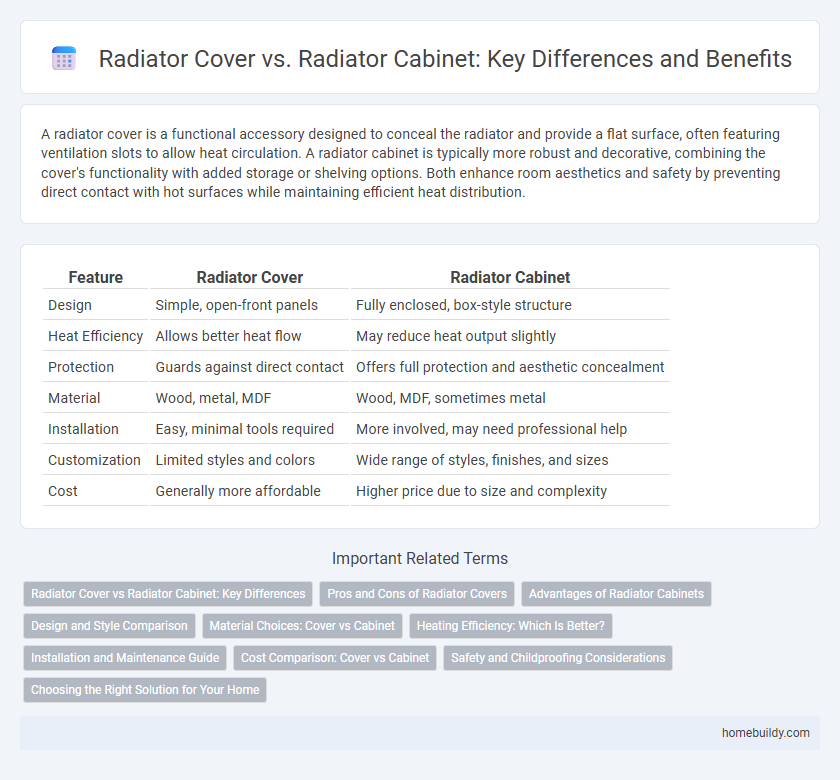A radiator cover is a functional accessory designed to conceal the radiator and provide a flat surface, often featuring ventilation slots to allow heat circulation. A radiator cabinet is typically more robust and decorative, combining the cover's functionality with added storage or shelving options. Both enhance room aesthetics and safety by preventing direct contact with hot surfaces while maintaining efficient heat distribution.
Table of Comparison
| Feature | Radiator Cover | Radiator Cabinet |
|---|---|---|
| Design | Simple, open-front panels | Fully enclosed, box-style structure |
| Heat Efficiency | Allows better heat flow | May reduce heat output slightly |
| Protection | Guards against direct contact | Offers full protection and aesthetic concealment |
| Material | Wood, metal, MDF | Wood, MDF, sometimes metal |
| Installation | Easy, minimal tools required | More involved, may need professional help |
| Customization | Limited styles and colors | Wide range of styles, finishes, and sizes |
| Cost | Generally more affordable | Higher price due to size and complexity |
Radiator Cover vs Radiator Cabinet: Key Differences
Radiator covers and radiator cabinets both serve to conceal unsightly radiators while enhancing room aesthetics, but they differ in design and functionality. Radiator covers typically feature open slats or mesh panels that allow efficient heat circulation, ensuring optimal warmth, whereas radiator cabinets often have solid fronts that can slightly reduce heat flow but provide a more enclosed, furniture-like appearance. Selecting between a radiator cover and a radiator cabinet depends on balancing heat distribution needs with style preferences and room decor.
Pros and Cons of Radiator Covers
Radiator covers improve safety by preventing burns and protect radiators from dust while enhancing room aesthetics through customizable designs. However, they may slightly reduce heating efficiency by obstructing heat flow if not properly ventilated. Compared to radiator cabinets, covers are generally more affordable and easier to install but offer less storage or decorative functionality.
Advantages of Radiator Cabinets
Radiator cabinets provide superior protection by enclosing the entire radiator, reducing the risk of burns and accidents, especially in homes with children or pets. They also enhance aesthetic appeal by offering customizable designs that blend seamlessly with interior decor, while allowing better airflow compared to basic covers. Furthermore, radiator cabinets contribute to improved heat distribution, ensuring efficient warming of the room without obstructing the radiator's performance.
Design and Style Comparison
Radiator covers typically feature minimalist designs that emphasize airflow while blending seamlessly with modern interiors, often crafted from metal or sleek wood panels. Radiator cabinets offer more substantial construction with detailed craftsmanship, incorporating decorative elements such as molding and latticework that enhance traditional or classic room styles. The choice between a radiator cover and a cabinet depends on the desired aesthetic impact and level of design sophistication, with covers favoring contemporary simplicity and cabinets providing ornate elegance.
Material Choices: Cover vs Cabinet
Radiator covers are typically made from lightweight materials such as MDF, plywood, or metal, providing easy customization and ventilation, whereas radiator cabinets often utilize sturdier materials like solid wood or hardwood for enhanced durability and aesthetic appeal. Covers prioritize heat efficiency with perforated or slatted designs, while cabinets focus on blending with interior decor through more substantial, decorative panels. Material choice influences not only visual style but also heat distribution and maintenance requirements between covers and cabinets.
Heating Efficiency: Which Is Better?
Radiator covers typically allow better heat circulation due to their open designs, which maximize airflow and maintain heating efficiency. Radiator cabinets, often bulkier and enclosed, can trap heat and reduce the overall warmth emitted into a room. For optimal heating efficiency, choosing a minimalist radiator cover with ventilation slots is generally more effective than a fully enclosed radiator cabinet.
Installation and Maintenance Guide
Radiator covers typically offer easier installation than radiator cabinets, as they are designed to fit directly over the radiator without extensive modifications to the surrounding space. Maintenance of radiator covers involves simple cleaning and occasional repainting, whereas radiator cabinets may require regular inspection for structural integrity and more complex cleaning due to their bulkier design. Choosing between the two depends on the desired balance between installation simplicity and aesthetic customization options.
Cost Comparison: Cover vs Cabinet
Radiator covers generally cost less than radiator cabinets due to their simpler design and lighter materials, making them a budget-friendly option for enhancing radiator aesthetics. Radiator cabinets, often crafted from solid wood or more durable materials, tend to have higher prices reflecting their sturdier construction and added storage or design features. Comparing prices, covers typically range between $50 and $150, while cabinets can exceed $200, influencing the decision based on cost efficiency and functional requirements.
Safety and Childproofing Considerations
Radiator covers and radiator cabinets both enhance safety by preventing direct contact with hot surfaces, reducing burn risks, especially for children. Radiator covers typically offer open designs that allow better heat circulation while providing a physical barrier, whereas radiator cabinets often fully enclose the radiator, requiring careful selection to ensure adequate ventilation and heat efficiency. For optimal childproofing, radiator covers with sturdy, non-toxic materials and smooth edges are preferred to minimize injury risks without compromising heating performance.
Choosing the Right Solution for Your Home
Radiator covers offer a sleek, minimalistic design that improves room aesthetics while allowing efficient heat circulation through perforated panels. Radiator cabinets typically provide enclosed storage space, creating a multifunctional furniture piece but may restrict heat flow if not properly ventilated. Prioritize compatibility with your radiator type, room size, and desired level of heat efficiency when choosing between covers and cabinets for optimal home comfort.
Radiator cover vs radiator cabinet Infographic

 homebuildy.com
homebuildy.com